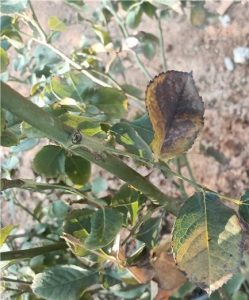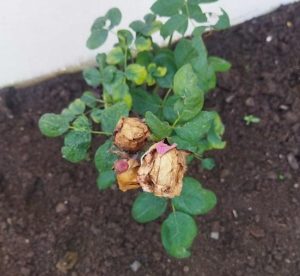Roses are one of the most popular ornamental plants grown worldwide, appreciated for their beauty, fragrance and wide range of colors. However, like any other plant species, roses are also susceptible to various diseases, including Botrytis blight. Botrytis blight is a fungal disease that affects roses and other ornamental plants. This article will explore the causes, symptoms, and management of Botrytis blight of rose.
Botrytis blight of rose is a major disease that can cause significant economic losses to the ornamental plant industry. The disease can reduce the quality and yield of roses, affecting the marketability of the plants. Botrytis blight develops under conditions of high humidity, especially in the presence of free moisture. The fungus can infect roses through wounds or natural openings, such as stomata or hydathodes and can survive in plant debris or infected plant material.
Type of Infestation in Botrytis blight of rose
Botrytis blight has a complex disease cycle that involves primary and secondary infections.
- Primary infections occur when the spores of the fungus land on the plant surface and germinate, penetrating the host tissue.
- Secondary infections occur when the fungus spreads from the initial site of infection to other parts of the plant or other nearby plants. The fungus can also survive in plant debris or in the soil, serving as a source of inoculum for new infections.
Scientific Name: Botrytis cinerea
Most Affected States
Botrytis blight can occur in any region where roses are grown, but it is more common in areas with high humidity and rainfall. In India, the disease is prevalent in the states of West Bengal, Uttar Pradesh, Haryana, and Punjab.
Botrytis Blight of Rose Symptoms

- Botrytis blight can affect various parts of the rose plant, including the stems, leaves and flowers.
- The initial symptoms of the disease are small brown spots on the leaves or stems that enlarge and become covered in a grey mold.
- Greyish brown fungal growth can be observed on the leaves and flowers. Small flecks can be seen on the infested petals.
- As the disease progresses, the mold can spread to other parts of the plant, causing the leaves and flowers to wilt and turn brown.

Botrytis Blight of Rose Control Measures
The management of Botrytis blight in roses requires a combination of cultural, biological, and chemical control measures.
Cultural Measures
- Providing adequate spacing between the plants ensures proper air circulation and reduces humidity levels.
- Avoid overhead irrigation, instead drip irrigation can be used to keep the foliage dry.
- Remove all weeds and debris from the rose beds to prevent the build-up of inoculum.
- Ensure good drainage in the growing area.
- Pruned parts should be coated/treated with Bordeaux paste/Bordeaux mixture.
Mechanical Measures
- Destruction of dead plant parts can reduce the further spread of botrytis fungus.
- Pruning of infected plant parts should be done as soon as they are observed.
Biological Measures
- Anshul Tricomax Bio fungicide contains Trichoderma viride which suppresses the growth of pathogen by producing antibiotics. The recommended dosage is 3 gm per liter of water.
- Mildown Bio fungicide contains bacillus subtilis which competes with the disease-causing organisms and induces systemic acquired resistance against bacterial pathogens. Treat the rose saplings with Mildown at 5 ml per liter of water before planting.
- Milgo Bio Fungicide contains parasitic fungus Ampelomyces quisqualis which when used at the rate of 5-10 ml per liter water with 10-15 days interval between sprays can effectively control botrytis disease in rose.
Chemical Measures
Chemical control is an important aspect of managing Botrytis blight in roses. Some commonly used fungicides for Botrytis blight in roses include:
| Product Name | Technical Content | Dosage |
| Kavach Fungicide | Chlorothalonil 75% WP | 1-2 gm/liter of water |
| Latifa Fungicide | Azoxystrobin 18.2% + Difenoconazole 11.4% SC | 0.5 ml/liter of water |
| Tilt Fungicide | Propiconazole 25 % EC | 1 ml/liter of water |
| Anand Agro Nano Shield | Hydrogen peroxide (H2O2) stabilized with Nanosilver | 2 ml/liter of water |
| Roko Fungicide | Thiophanate Methyl 70% WP | 0.5 gm/liter of water |
| Shamrock Overseas Borogold
|
Nano Silver Particles & Peroxy Acid | 1.5 gm/liter of water |
In conclusion, botrytis blight is a serious disease of roses that can cause significant damage to the plant and its economic value. It is important to take preventative measures such as proper cultural practices and timely application of fungicides to prevent the disease from spreading. With careful management, it is possible to minimize the impact of botrytis blight on roses and ensure their continued health and beauty.
Click here to explore our comprehensive guide on Rose: Planting And Package Of Practices.





